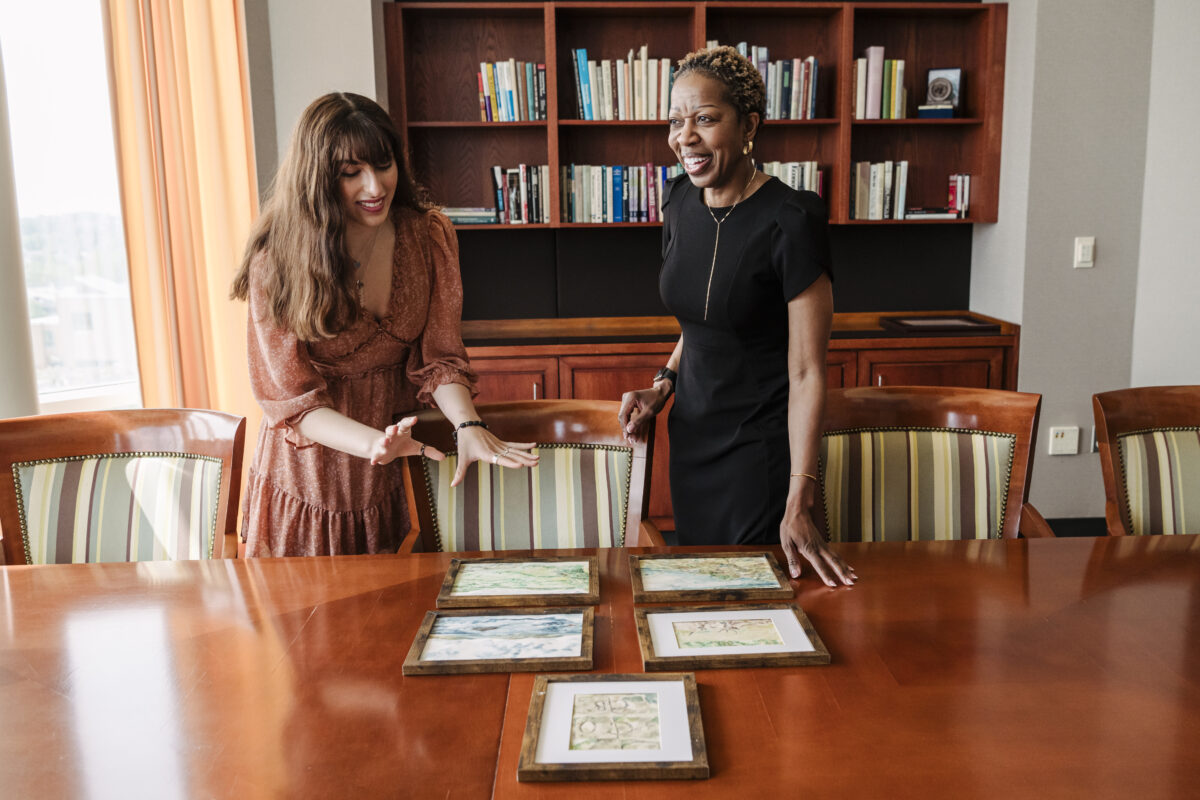
During her office hours, President Valerie Sheares Ashby makes it a point to meet weekly with students and hear about their UMBC experiences and their aspirations for life after UMBC. Today, Jenna Beshara, a senior English and visual arts double major, shares her Undergraduate Research and Creative Achievement Day (URCAD) project with the president. Beshara, who spent last summer on a study abroad program in Wales, painted a series of Welsh watercolor landscapes with paints she made herself using only natural ingredients. In this excerpt of their conversation, she and President Sheares Ashby discuss the importance of pursuing art and research through a sustainability lens.
President Sheares Ashby: These paintings are just beautiful. I feel like the water is just coming off the page. Is that the way you painted it or is it actually texture?
Jenna Beshara: Thank you! It’s a little bit of both, because the pigment—no matter how much you grind it or sift it—it’s still going to be a little bit coarse and gritty. I found out that it takes about a week to make one batch of pigment. You start with flowers or vegetables or plants—red cabbage actually makes the best blue—and you put them in a pot and pour boiling water over it. Then it’s a sequence of simmering and letting it rest. After you strain out all the materials, you add in a salt compound and baking soda. You grind what’s left, which turns into a mud-like consistency. It needs a week to dry and then you grind it and strain it several times.
But to make the paint, there’s quite a bit of chemistry involved. The idea just kind of came to me because acrylic paint is like liquid plastic. It’s really bad for the environment.
 Beshara shares her paintings with President Sheares Ashby.
Beshara shares her paintings with President Sheares Ashby.
Sheares Ashby: I am a polymer chemist, so I know what you mean. I appreciate that you did watercolor and environmentally friendly materials. That is very impressive. How did you decide to start this project?
Beshara: After I came back from Wales, I knew I wanted to apply for a Fulbright student grant to do more arts research. My mentor, Timothy Nohe, a professor in visual arts, suggested I use URCAD as a jumping-off point for my research project. He supports me in everything that I do. I’ll come to him and I’m like, “Hey, I want to do this.” And he’s like, “Awesome, do it.”
At one point in this project, I was so frustrated because I wanted to make oil paintings. The homemade oil wasn’t drying, and it looked so gritty. So I went to Professor Nohe and said, “I don’t know what I’m doing.” And he said, “Well, if the medium isn’t working, just change it.” And that blew my mind, and I was like, “Whoa, I can do that?”
Sheares Ashby: When I look at these paintings of these beautiful landscapes, it reminds me that from an environmental framework that if we do not care for this, it will not continue to look like this. This beauty that you have captured is not guaranteed. We have a responsibility to keep this as beautiful as it is.
“I love UMBC because our students are so focused on making some version of difference in the world, no matter the discipline.
President Valerie Sheares Ashby
Beshara: I’m applying for an Undergraduate Research Award to keep studying this because the supplies to make the paint can get a little pricey. But it’s so important, with climate change, that sustainability and art can go hand-in-hand.
Sheares Ashby: I love UMBC because our students are so focused on making some version of difference in the world, no matter the discipline. It is rare that I run into a student who doesn’t think about whatever they care about in an interdisciplinary way. Most of my students—like you—are thinking about how they are going to change something in the world to make it better.





